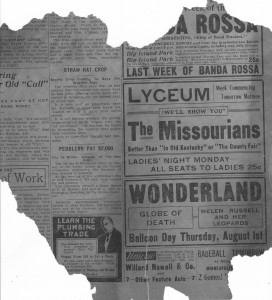
There is one Depression-era photograph of the cemetery in the Library of Congress collection. It was taken in 1939 by John Vachon, a 25-year-old St. Paul, MN native. Vachon was hired by the Farm Security Administration to document living conditions, especially of the poor, during the Depression. The view is of the southwestern section of the cemetery. Note the two buildings in the background; both still exist although the one of the southeast corner of Cedar and Lake is one story shorter. Also note how small the trees were and the systematic planting of trees along the Lake Street edge.
September 11, 2013 marks the 160th anniversary of the first burial in Layman”'s (now Minneapolis Pioneers and Soldiers Memorial Cemetery). Carlton John Cressey, son of a Baptist minister, died of consumption at the age of ten months and nine days. His was the first of what would be 27,000 burials in a little less than 60 years. The base of a marker is located on Carlton”'s grave; the tablet and inscription disappeared many years ago, most likely before a survey of the cemetery”'s markers was conducted during the Depression. The number of markers, their styles, materials and location were recorded but no known photographic study was conducted.
Consumption/tuberculosis caused billions of deaths
Consumption is an ancient enemy. It has caused billions of deaths worldwide. Human bones from the Near East dating back five millennia show the telltale pitting of consumption. Mummies from Egypt ca. 2400 BCE show tubercular decay in their spines. The ancient Greeks described it, too. Around 460 BCE, Hippocrates identified phthisis, or consumption, as the most widespread disease of his age. It was almost always fatal. Because of that, he advised his followers and students against treating late-stage consumption to avoid damage to their reputations.
Any disease that consumed any portion of the body was called consumption for a long time until 1882 when microbiologist Robert Koch discovered the tubercle bacillus. Then it began to be called Tuberculosis. TB is a potentially fatal contagious disease that can affect almost any part of the body but is mainly an infection of the lungs caused by a bacterial microorganism tubercle bacillus. In the early 1800s TB may have caused about 1/3 of all deaths. Each year there are more than 1.4 million TB-related deaths worldwide.

This ad for Wonderland Amusement Park, 31st and Lake Street from 1905 to 1911, was recently found beneath wood siding on a house four blocks away. It was in a July 23, 1908 Minneapolis Journal newspaper.









